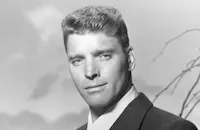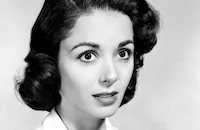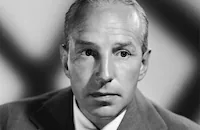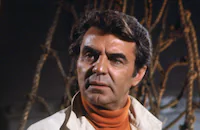Airport

Brief Synopsis
Cast & Crew
George Seaton
Burt Lancaster
Dean Martin
Jean Seberg
Jacqueline Bisset
George Kennedy
Film Details
Technical Specs

Synopsis
Mel Bakersfeld, general manager of Lincoln International Airport, is beset with problems during one of the worst snowstorms in the history of the Midwest. A disabled jet has blocked the major runway, and the auxiliary runway is too short for takeoffs in bad weather conditions, forcing Mel to call maintenance chief Joe Patroni to solve the crisis; Mel's wife, Cindy, informs him that she wants a divorce; and Tanya Livingston, the Trans Global Airlines passenger agent with whom Mel is having an affair, is distracted by the mischievous Ada Quonsett, an elderly woman who is trying to stow away on a jet to Rome. Meanwhile, the emotionally disturbed D. O. Guerrero comes on board with a bomb in a briefcase, intending to blow up the plane so that his wife, Inez, can collect on the life insurance policy he has just purchased. The jet is piloted by Mel's brother-in-law, Vernon Demerest, who has just learned that his lover, stewardess Gwen Meighen, is pregnant. Shortly after departure, he is warned that Mel and Tanya have determined that Guerrero is carrying a bomb. With Ada's help, Vernon attempts to get the briefcase, then nearly succeeds in persuading Guerrero not to open it, but Guerrero runs into the bathroom and explodes the bomb. Guerrero is blown out of the jet, Gwen suffers a serious eye injury, and the aircraft is severely crippled, but Vernon and co-captain Anson Harris manage to land on Lincoln's runway, which Patroni has just cleared. As the passengers and crew enter the terminal, Vernon's wife, Sarah, observes her husband's obvious concern for Gwen and realizes that he has been unfaithful.

Director
George Seaton
Cast

Burt Lancaster

Dean Martin

Jean Seberg

Jacqueline Bisset

George Kennedy

Helen Hayes

Van Heflin

Maureen Stapleton

Barry Nelson

Dana Wynter

Lloyd Nolan

Barbara Hale
Gary Collins
John Findlater

Jessie Royce Landis

Larry Gates
Peter Turgeon

Whit Bissell

Virginia Grey
Eileen Wesson

Paul Picerni
Robert Patten
Clark Howat
Lew Brown
Ilana Dowding
Lisa Garritson
Jim Nolan
Patty Poulsen
Ena Hartman
Malila Saint Duval
Sharon Harvey
Albert Reed
Jodean Russo
Nancy Ann Nelson
Dick Winslow
Lou Wagner
Janis Hansen
Mary Jackson
Shelly Novack
Chuck Daniel
Charles Brewer
Crew
Betty Abbott
Preston Ames
Lee Danielson
John N. Denend
Larry Germain
Stuart Gilmore
Alexander Golitzen
James Gordon
Ray Gosnell
Henry Hathaway
Edith Head
Ross Hunter
Ernest Laszlo
Jacque Mapes
Mickey S. Michaels
Jack D. Moore
David H. Moriarty
Alfred Newman
Ronald Pierce
Peter Price
Donald Roberts
Arnold Schwarzwald
George Seaton
Waldon O. Watson
Don W. Weed
Bud Westmore

Videos
Movie Clip



Film Details
Technical Specs

Award Wins
Best Supporting Actress
Best Supporting Actress
Award Nominations
Best Art Direction
Best Cinematography
Best Costume Design
Best Editing
Best Music Original Dramatic Score
Best Picture
Best Sound
Best Writing, Screenplay
Articles
Airport
A veritable "who's who" of the top box office stars and prominent character actors of its era, Airport was trashed in reviews by many prominent critics but proved to be a major hit with the public. It also earned a total of ten Academy Award nominations including one for Best Picture. This was probably the first time since Cecil B. DeMille's circus epic, The Greatest Show on Earth (1952), that such a blatantly commercial film had received so many Oscar nominations. Airport soon became a franchise and three sequels followed: Airport 1975 (1974), Airport '77 (1977), and The Concorde: Airport '79 (1979). Since each sequel got progressively sillier and more outlandish, it was only a matter of time until a parody of the series appeared which eventually happened in 1980 with the release of Airplane! from comedy writers David and Jerry Zucker and director Jim Abrahams. It was followed by Airplane II: The Sequel (1982).
Despite the end result, Airport was not an easy film to shoot. Screenwriter-turned-director George Seaton was unable to get permission to film at either the LAX or O'Hare airports so he resorted to shooting all interiors at the Universal soundstages and some exteriors at the St. Paul Airport in Minneapolis. Seaton also had to contend with Burt Lancaster's forceful personality on the set (Gregory Peck had been the original choice for the role). Lancaster was used to much more creative control on films and would occasionally question the director's decisions. Lancaster also was unsatisfied with the performance of his co-star Jean Seberg and later admitted that he only chose to do the film for commercial reasons. Although it would prove to be the most profitable film of his career, Lancaster would refer to it later as "the biggest piece of junk ever made." Seberg, for her part, hated her role and her gray, mini-skirted uniform that she thought made her look like a clown. It was quite a step-down from her critically acclaimed performances in such films as Jean-Luc Godard's Breathless (1960) or Robert Rossen's Lilith (1964). On a more positive note, however, Airport was a great career move for George Kennedy who got to play the hero of the film - airport maintenance chief Joe Patroni, the man who clears the snowbound runway so the Boeing 707 can safely land. Helen Hayes also profited from the film, winning the Best Supporting Actress Oscar for her role as Ada Quonsett, a mischievous stowaway.
Director: George Seaton
Producer: Ross Hunter
Screenplay: George Seaton
Cinematography: Ernest Laszlo
Editor: Stuart Gilmore
Art Direction: E. Preston Ames, Alexander Golitzen
Music: Alfred Newman
Cast: Burt Lancaster (Mel Bakersfeld), Dean Martin (Vernon Demerest), Jean Seberg (Tanya Livingston), Jacqueline Bisset (Gwen Meighen), George Kennedy (Joe Patroni), Helen Hayes (Ada Quonsett), Van Heflin (D.O. Guerrero), Maureen Stapleton (Inez Guerrero).
C-137m. Letterboxed.
by Jeff Stafford

Airport
Quotes
My late husband played the violin. Not professionally, but he was very good. He once played the Minute Waltz in 58 seconds.- Ada Quonsett
Hold on, we're goin' for broke!- Joe Patroni
I'll be back in time if I have to pull that plane out with my teeth!- Joe Patroni
Let us put it this way: You promised me a box of cigars if I pull this off, right? Well, what're you standing here for? Go get 'em!- Joe Patroni
Don't talk to me about consequences! When Congress voted to cut airport appropriations, you never even sent in a letter of protest. And where were you when the airlines and the pilots and the rest of us were... were pleading for... for more airports and better traffic control? You were picking out the colors in the ladies' lounge. So now you've got your consequences!- Mel Bakersfeld
Trivia
The real star of the show, the Boeing 707 (a 707-349C, serial no. 19351[503rd 707 off the production line], originally registered N324F), was leased to MCA/Universal Pictures from Flying Tiger Line (now merged with Fedex) for the filming of the exterior shots. After filming was completed, the aircraft returned to Flying Tigers and was later sold, going through various owners before meeting a tragic end in a takeoff accident on 21 March 1989 in Sao Paulo, Brazil.
Trans Global Airlines was the name of the notional airline for the film. For many years it was not unusual to see props from the movie (with the fictional TGA logo) in other Universal films where airliner interior scenes were shot.
Expanded from a Canadian TV production Hailey wrote called Flight Into Danger (1956) (TV).
At 'Dean Martin' 's request, Petula Clark was originally offered the role of Gwen Meighen.
Dean Martin received 10% of the film's gross which added an additional $7,000,000 to his salary.
Notes
Location scenes filmed at Minneapolis-St. Paul International Airport. Hathaway directed some scenes during Seaton's illness.

Miscellaneous Notes
Released in United States Winter January 1, 1970
Released in United States March 5, 1970
Released in United States on Video January 12, 1994
Released in 35mm and 70mm prints.
Henry Hathaway directed some scenes while George Seaton was ill.
Todd-AO
Released in United States Winter January 1, 1970
Released in United States March 5, 1970
Released in United States on Video January 12, 1994













